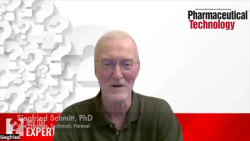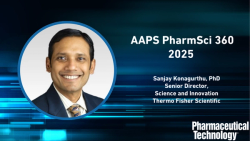
OR WAIT null SECS
- About Us
- Advertise
- Contact Us
- Editorial Info
- Editorial Advisory Board
- Do Not Sell My Personal Information
- Privacy Policy
- Terms and Conditions
© 2025 MJH Life Sciences™ , Pharmaceutical Technology - Pharma News and Development Insights. All rights reserved.
Why Sound Science Is Pharma's Best Defense Against Regulatory Shifts
Nigel Langley of gChem discusses the company’s DMSO, proactive pharma strategies, and more in part 1 of a 2-part interview related to his presentation at CPHI Europe 2025.
*Access a full transcript of the video interview below
In this part 1 of a 2-part interview regarding his presentation, “Challenges to the Sustained Availability of Excipients” at CPHI Europe 2025, held Oct 28-30 in Frankfurt, Germany, Nigel Langley, Global Technical Director of Life Sciences at gChem and immediate past chair of IPEC-Americas, discusses gChem's offerings at the conference, regulatory challenges facing excipients, and how the pharmaceutical industry can respond to them.
At CPHI, gChem is presenting its Procipient dimethyl sulfoxide (DMSO), a high-purity, pharmaceutical-grade product with applications as both an API and an excipient. This product is supported by a type two drug master file with the FDA in the US and a type one file in Canada. In addition to Procipient, gChem will promote two other DMSO grades: a synthesis grade for API and peptide synthesis, and an American Chemical Society analytical grade for laboratories and diagnostics.
Langley identifies the most pressing regulatory challenge as the "daily shift" in focus on different safety concerns for traditional excipients. He cites numerous examples, including issues with titanium dioxide (TiO2), potential nitrosamine connections, microplastics, and PFAS (per- and polyfluoroalkyl substances). More recent scrutiny in the US has targeted synthetic color additives and talc, keeping industry organizations like IPEC busy. This constant stream of emerging concerns makes it difficult for the industry to keep up.
Regarding how pharmaceutical companies can better anticipate these challenges, Langley acknowledges that it is difficult to be proactive. He stresses that the industry's response should be rooted in sound science. He criticizes how isolated or questionable scientific papers can sometimes used to drive regulatory decisions. Langley points to the industry's successful response to the proposed ban on TiO2 in Europe as a model for future action. The industry countered by presenting strong scientific evidence, highlighting the potential for massive drug shortages and the lack of viable alternatives. This fact-based, non-melodramatic approach ultimately prevailed. Langley believes this method of presenting robust scientific facts is how the pharmaceutical world should proactively tackle future regulatory challenges.
Look for Part 2 of this interview and access all our CPHI Europe coverage!
Transcript
*Editor’s Note: This transcript is a direct, unedited rendering of the original audio/video content. It may contain errors, informal language, or omissions as spoken in the original recording.
Hi everyone. My name is Nigel Langley. I'm the global technical director of Life Sciences at gChem. I'm also the immediate past chair of IPEC-Americas, and the two roles actually provide the opportunity to be involved in the industry from the excipient side. So, for gChem, I help to support our customers and formulators in those companies with their challenges for formulation, supporting their work with our pharmaceutical grade dimethyl sulfoxide, which is DMSO, which is known as Procipient.
At CPHI this year, we will be presenting and promoting our Procipient dimethyl sulfoxide product, which is our high-purity, pharmaceutical-grade DMSO. And that has both an API and an excipient application. We support this with a Type II Drug Master File in the US with the FDA, and a Type I Drug Master File in Health Canada.
But it's also an excipient, so it has multiple functions. In addition to Procipient, we will be also promoting two other grades of DMSO that we have in our portfolio. One is our synthesis grade, which is targeted towards API synthesis as a solvent, and also peptide synthesis, which is a growing market and growing area.
And the third being our ACS grade, which is our analytical grade, which is really focused and targeted towards laboratories for reagent grades, for diagnostics, etc.
The most pressing challenge that we see, and particularly through IPEC-Americas and IPEC in general, is the daily shift in what to focus on next. We've had issues around safety concerns around quite a lot of the traditional excipients, like titanium dioxide, for example. We've had issues with nitrosamines and the possible connection with excipients, as well as drug products.
We've had issues in, with challenges with microplastics, with PFAS. There's a lot of impurities or that type of issue that's come through, some of which have been driven from Europe, some of which have been driven from the US. More recently in the US, there's, an opportunity, if that's the right word, of actually looking at color additives and synthetic ones that there's an initiative to scrutinize those and to ban certain colors. There's also more recently, talc is being on the microscope. And it's, it's really keeping IPEC busy, and the industry itself busy.
I think this is a difficult one because I think it's quite challenging for pharma companies to know how to react and be proactive in these types of instances. I think really, the science should prevail, the wealth of science in a particular area should be more compelling. I think what's happened more recently is isolated scientific papers are being cited that may be not representative of the bulk of the knowledge about a certain topic, and decisions are being made based on that type of science. And you can question whether that science is strong enough to actually warrant that type of discussion. This was an example that came from TiO2 [titanium dioxide].
The way that the industry responded to that, and, again, that came from Europe. The concern that TiO2 was banned in food and it looked like it was going to be banned in pharma products, in the pharmaceutical area. Well, if that happened, there would’ve been 90,000 drug products in Europe that would've had to be reformulated.
And, of course, a lot of those wouldn't have been reformulated because economically it wouldn't make any sense to do that. And there's no good alternative for TiO2. So how the industry responded, and it responded very well in my opinion, and took the science and questioned and challenged the citations that were being presented in Europe.
And although that took some time to actually re-present what's safe, and the world seemed to be divided on what was safe. The FDA actually saw no issues with the safety of TiO2. But in certain European countries, they did. The actual common sense, in my opinion, actually won the day in the end.
So, my point is I think the way that the pharma companies tackled that particular issue, because the impact of the patient could have been dramatic, you know, drug shortages if you have to reformulate, and as I mentioned, a lot of those products would probably not… the generics wouldn't have been reformulated because there's no economic gain to do it.
And they would've had to be reformulated with an inferior excipient to TiO2. It wasn't a simple case of just interchangeability with something else. The way that they reacted was a very positive way and not melodramatic, but just presenting the facts and the good science in that particular case. So I would imagine that's how, proactively, if this comes through, and I'm sure it will, another issue, how the pharma world will actually tackle that type of challenge.


